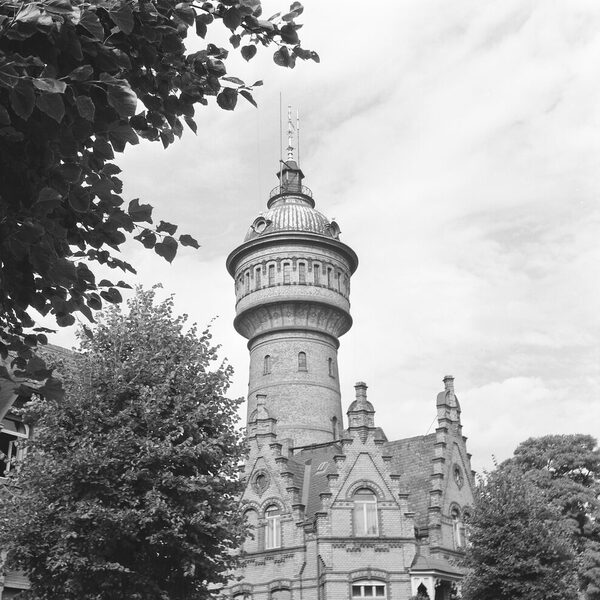Water supply
The oldest evidence of Wiesbaden's water supply dates back to the 1st century AD. Around 90 AD, members of the XIV Roman Legion poured lead pipes to collect water from the hot springs and channel it into a thermal bath. It was not until many centuries later that a water supply as we know it today was established.
In 1566, the Counts of Nassau-Idstein had a "jumping fountain" built on the square in front of their palace in Wiesbaden, which was fed by the Heiligenborn springs. Problems with the water supply had a centuries-old tradition in Wiesbaden: the downside of the blessings of the hot springs was that they precluded the extraction of good drinking water. In the Middle Ages, the inhabitants used the field wells in the vicinity of the city. From the 16th century onwards, the Nassau-Idstein state government had the Heiligenborn water piped to the market fountain in wooden pipes. In the period that followed, the water supply always lagged behind the development of the town.
New quantitative and qualitative requirements arose at the beginning of the 19th century. Further springs on the Taunus were used to supply the initially nine, then 17 running wells in the city; by 1860 there were 32 public wells. Increasing demand for water in the second half of the 19th century generally forced the use of groundwater, the quality and yield of which was increasingly being researched. The collection of the field wells close to the town and the spring horizon below the Platte and, from 1870, the water from the Pfaffenborn ("Klosterbruch") above the Fasanerie provided short-term relief before the water resources of the quartzite layers of the Taunus could be tapped from 1875 thanks to the geological findings of Dr. Carl Koch. Between 1875 and 1910, four impressive tunnels with a total length of over 11 km, veritable "drinking water mines", were used to tap the water resources. The portal structures of the tunnels (Kellerskopf, Münzberg, Schläferskopf and Kreuzstollen) are regarded by experts as technical monuments of national importance.
However, towards the end of the 19th century, it became clear that water extraction from the Rhine would also be necessary to secure Wiesbaden's supply. In 1899, the first test drillings began on the site between Schierstein and Niederwalluf, the results of which led to the construction of a waterworks. The water extracted near the Rhine was fed into the Wiesbaden water network for the first time on June 24, 1905. In the summer of 1907, the entire drinking water extraction area was diked. In 1920-28, the Schierstein waterworks, a groundwater treatment plant, was expanded under the management of Christian Bücher.
The supply area was extended in the course of incorporation (1926, 1928 and 1977). The water supply to the Wiesbaden suburbs had previously been very different, depending on the geographical location. The Kalle emergency waterworks was built in 1946/47 in order to be able to bridge problems with the water supply for the population despite the war damage after the Second World War. The 1950s were characterized by the municipal utility's water extraction policy, which was increasingly focused exclusively on Schierstein. Only there was the concrete prospect of being able to keep pace with the dramatic increase in consumption, at least temporarily, by accelerating the expansion of the plant. Alternative solutions, the pursuit and at least partial realization of which would shape the next decade, did not emerge at that time.
Construction measures for American occupation personnel in the Aukammtal valley in Bierstadt were the reason for a rare project in hilly Wiesbaden. Despite the construction of a water reservoir at the "Fichten", which had a capacity of 200m3, this alone was not enough to supply the almost 600 apartments. It was therefore necessary to install a 28 m high water tower on the ridge between Sonnenberg and Bierstadt, but on Rambach land, at 283.05 m above sea level, which was completed in 1957. At the end of the 1950s, only the expansion of the Schierstein waterworks was seen as the solution to meet the increasing demand. Construction of the 3rd plant was completed in 1961.
With the completion of the expansion work, all usable sources within the city area had been tapped. Nevertheless, the town was not spared water shortages in the following years until the end of the 1960s, when it finally succeeded in connecting to the water resources of the Hessian Ried. On October 12, 1968, the waterworks built in the Jägersburger Wald near Einhausen was inaugurated and was able to supply almost 50,000m3 of drinking water to Frankfurt am Main and Wiesbaden every day.
Today (as of 2015), Wiesbaden is supplied with 40 % of its water from the Hessian Ried, 30 % of the water is obtained from the Taunus and a further 30 % from the waterworks in Schierstein.
Literature
Kopp, Klaus: Water from the Taunus, Rhine and Ried. From two millennia of Wiesbaden's water supply, Wiesbaden 1986.
